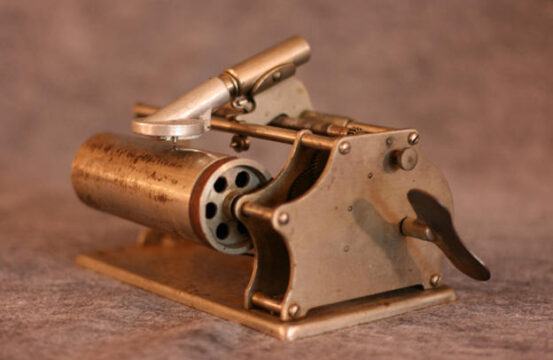
The Rosenberg Library featured a Columbia Type Q Graphophone as the August Treasure of the Month. The graphophone, far from today’s world of digital media players or smart phones, was an early audio player. Powered by a hand crank, it used wax instead of tin to play audio signals of up to two minutes. The graphophone not only improved the medium that recordings were done on, but it also changed the method. It used a lateral recording technique which improved sound fidelity and more playbacks. These innovations resulted in a better quality of sound that could outlast its metal counterpart. This month’s Treasure was donated to the Library in 1932 by Mrs. H. G. Gray.
The story of the graphophone involves some of the best known American inventors and sheds light on how the search for profits led to technological innovation. Popular between the late 1880s through the late 1910s, graphophones emerged as a variation of the phonograph, another sound reproduction device. Both devices were audio machines in which sound vibrations made indentations onto a medium (either tin or wax) by speaking into a mouthpiece, and then had a separate mechanism for playback. In Galveston, graphophones were used for personal entertaining, group lessons, and were even used to record religious sermons.

Corporations such as the American Graphophone Company, North American Phonograph Company, and the Columbia Phonograph Company continuously improved, patented, and marketed new products. Inventors of early sound recorders like Thomas Edison, Charles S. Tainter, and Alexander G. Bell believed their machines would revolutionize office dictation and education. In fact two stenographers to the Supreme Court, Paul Cromelin and Edward Easton, were the founders of the Columbia Phonograph Company, but their efforts to transform the dictation industry were mostly unsuccessful.
One problem that arose from the race to build the next best product was the issue of “compatibility.” In the early 1900s, phonograph and graphophone records were not interchangeable, and both Columbia and Edison introduced variations on the basic technology (such as longer-playing or larger diameter cylinders) that did not work on older models. To make matters worse, new inventors flooded the market with even more variations of graphophones to cash in on the booming home entertainment market. Local distributors then focused on a niche market for the machines: amusements, fairs, and resorts. Improvements to the phonograph and graphophone eventually culminated with the invention of the inexpensive home record player.
The Graphophone at the Rosenberg Library is a Columbia Type Q, which was designed and patented by Thomas Macdonald in 1897 and first sold commercially two years later. The Type Q was small, light weight, and with a $5 price tag was fairly affordable. The single spring motor, regulated by an elegant 3-ball governor, was powered by a simple winding key. The long horn which is included with treasure was likely an after-market purchase or came from another model, as the Type Q usually came with a simple 10 inch tin horn. It also would have likely come with a cardboard case and small wooden platform, neither of which still accompanies the piece.
Without the hard work and risks taken by inventors and investors like Bell and Tainter, Easton and Cromelin, or Thomas Macdonald it is unlikely that innovations in audio reproduction would have occurred as quickly as they did. The state of “writing sound” (a loose translation of the Greek components of the word ‘graphophone’) today in some ways mirrors that of a hundred years ago. We still have many competitors (although today it is Windows versus Apple rather than Edison versus Columbia) vying for larger shares of a growing market, who use various (digital) formats with differing levels of quality to entice customers to consume more media.